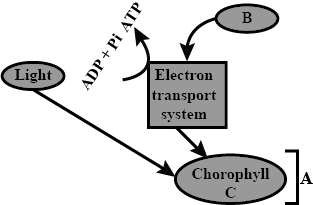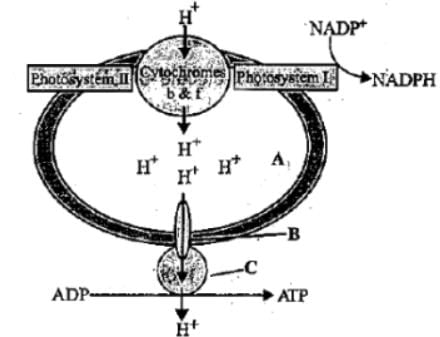Test: Photochemical Phase - NEET MCQ
15 Questions MCQ Test - Test: Photochemical Phase
Which of the following is produced during the light phase of photosynthesis?
________ is the process of synthesis of ATP from ADP and Pi in the presence of light.
| 1 Crore+ students have signed up on EduRev. Have you? Download the App |
The reaction center for PS- I ______ and reaction center of PS- II is ______.
Read the following statement and select the correct ones.
(i) PS I is involved in non-cyclic photophosphorylation only.
(ii) PS II is involved in both cyclic and non-cyclic photophosphorylation.
(iii) Stroma lamellae membranes possess PS I only, whereas grana lamellae membranes possess both PS I and PS II.
Study given flow chart of cyclic photophosphorylation and select the correct answer for A, B and C.

Refer to the given reaction.
2H2O → 4H+ + O2 + 4e−
Where does this reaction take place in the chloroplasts of plants?
Which one of the following is essential for the photolysis of water?
During non-cyclic photophosphorylation, electrons are continuously lost from the reaction centre of PSII. Which source is used to replace these electrons?
Read the given statements and select the correct option.
Statement 1 : In photosynthesis, during ATP synthesis, protons accumulate in the lumen of thylakoid.
Statement 2 : In respiration, during ATP synthesis, protons accumulate in the intermembrane space of mitochondria.
Assume a thylakoid which is somehow punctured so that the interior of the thylakoid is no longer separated from the stroma. This damage will have the most direct effect on which of the following processes?
Identify the parts marked as A, B and C in the given figure showing ATP synthesis through chemiosmosis.

In cyclic photophosphorylation, the electron released by reaction centre (P700) is ultimately accepted by



















